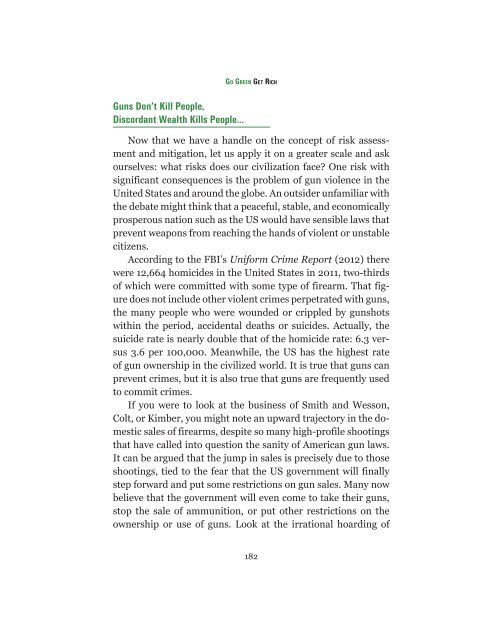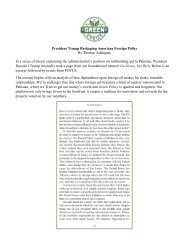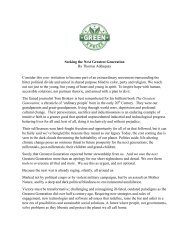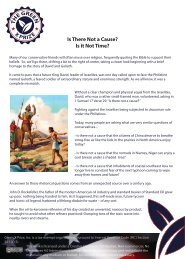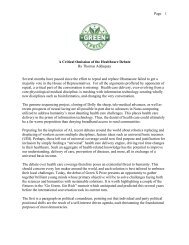Guns Don't Kill People...
- No tags were found...
Create successful ePaper yourself
Turn your PDF publications into a flip-book with our unique Google optimized e-Paper software.
GO GREEN GET RICH<br />
<strong>Guns</strong> Don’t <strong>Kill</strong> <strong>People</strong>,<br />
Discordant Wealth <strong>Kill</strong>s <strong>People</strong>…<br />
Now that we have a handle on the concept of risk assessment<br />
and mitigation, let us apply it on a greater scale and ask<br />
ourselves: what risks does our civilization face? One risk with<br />
significant consequences is the problem of gun violence in the<br />
United States and around the globe. An outsider unfamiliar with<br />
the debate might think that a peaceful, stable, and economically<br />
prosperous nation such as the US would have sensible laws that<br />
prevent weapons from reaching the hands of violent or unstable<br />
citizens.<br />
According to the FBI’s Uniform Crime Report (2012) there<br />
were 12,664 homicides in the United States in 2011, two-thirds<br />
of which were committed with some type of firearm. That figure<br />
does not include other violent crimes perpetrated with guns,<br />
the many people who were wounded or crippled by gunshots<br />
within the period, accidental deaths or suicides. Actually, the<br />
suicide rate is nearly double that of the homicide rate: 6.3 versus<br />
3.6 per 100,000. Meanwhile, the US has the highest rate<br />
of gun ownership in the civilized world. It is true that guns can<br />
prevent crimes, but it is also true that guns are frequently used<br />
to commit crimes.<br />
If you were to look at the business of Smith and Wesson,<br />
Colt, or Kimber, you might note an upward trajectory in the domestic<br />
sales of firearms, despite so many high-profile shootings<br />
that have called into question the sanity of American gun laws.<br />
It can be argued that the jump in sales is precisely due to those<br />
shootings, tied to the fear that the US government will finally<br />
step forward and put some restrictions on gun sales. Many now<br />
believe that the government will even come to take their guns,<br />
stop the sale of ammunition, or put other restrictions on the<br />
ownership or use of guns. Look at the irrational hoarding of<br />
182
SUSTAINABLE WEALTH<br />
ammo that followed the election of President Obama. The empty<br />
shelves of the gun stores should tell you all you need to know<br />
about how real and how deeply felt are those fears. The lack of<br />
legislative action and administrative power should also tell you<br />
how irrational they are.<br />
The majority of firearms produced by gun manufacturers<br />
are bought, sold, and distributed among the US population.<br />
Why would a stable country such as ours be so obsessed with<br />
gun ownership?<br />
To understand our gun culture one must go all the way back<br />
to colonial times. The frontier held grave dangers from wild<br />
beasts, hostile natives, and oppressive governments. If you sent<br />
a man to venture into the Carolina swamps or backwoods in the<br />
18 th century without a gun for protection, you could not reasonably<br />
expect that he would return. While some local tribes<br />
such as the Catawba or Yamacraw became friendly allies, others<br />
remained quite hostile. Deadly battles were commonplace in<br />
our history. If these dangers were not enough to prompt almostuniversal<br />
gun ownership, the oppression of the European governments<br />
demanded it.<br />
We have already discussed the failing of the British control<br />
of its colonies, but the French and the Spanish were no<br />
better. The colonists did not gain their independence by the<br />
benevolence of their monarchs. They won it with violent uprisings—with<br />
blood and guns. This situation did not improve<br />
much as the frontier moved west. The dangers of the wilderness<br />
changed but did not dissipate. We found new tribes to<br />
fight, and new wars to wage. The need for a man to own a gun<br />
changed little. It is now an ingrained part of our culture, a right<br />
protected by constitutional authority, and celebrated and mythologized<br />
by Hollywood.<br />
The prevalence of gun ownership in America presents us<br />
with a risk factor to consider: what is the probability that a gun<br />
183
GO GREEN GET RICH<br />
owner will one day shoot someone and what might be the effect<br />
of that?<br />
It can be rationally argued that crime in general—violent<br />
crime in particular and gun-related crime specifically—is directly<br />
related to poverty, unemployment, and desperation. While it<br />
has been often debated, it has never been proved…until lately.<br />
In 2011, the United Nations Office on Drugs and Crime supported<br />
a study which concluded that, while violence can be connected<br />
to gangs and organized crime,<br />
“The largest shares of homicides occur<br />
in countries with low levels of human<br />
development, and countries with high levels<br />
of income inequality suer homicide rates<br />
almost four times higher than more equal<br />
societies”.<br />
One of the original studies on this topic, conducted by Ichiro<br />
Kawachi of Harvard, found that income inequality accounted<br />
for 74 percent of the variance in murder rates and about half<br />
of the aggravated assaults (Kawachi, 1999). These results were<br />
surprisingly unambiguous. Even more surprising was that poverty<br />
alone explains the results, and other factors such as unemployment,<br />
alcohol consumption, and educational attainment<br />
were only weakly associated with or had no connection to violent<br />
crime at all. Kawachi’s findings have been confirmed by James<br />
Fearon of Stanford University, in a World Bank-sponsored<br />
study which confirmed these results on income inequality. It<br />
was found that on a worldwide basis, homicide rates are inextricably<br />
linked to the unequal distribution of resources (Fearon,<br />
2010). Dr. Fearon even looked specifically at countries plagued<br />
by drug wars and civil wars and found these to be only weakly<br />
correlated. The driving factors behind homicide and other<br />
184
SUSTAINABLE WEALTH<br />
violent crimes were still found to be income inequality and a<br />
lack of economic growth.<br />
In other words, while many things might affect the rates<br />
of homicide and, in particular, gun violence, nothing drives it<br />
more than income inequality. Poverty itself does not produce<br />
more violence as people do not fight over what others also do<br />
not have. Drug wars increase violence but that is a result of a<br />
few people acquiring great wealth and power because of the<br />
drug trade. Other factors may enter the equation but nothing<br />
drives violence quite like the deprivation of the many for the<br />
enrichment of the few. Add in the prevalence of gun ownership<br />
and a tradition or culture of violence and you have a toxic brew.<br />
The data and analyses bear out this rationale: gun violence is<br />
tied to unsustainable wealth and equity disparity.<br />
I believe that as we establish a more sustainable path of sharing<br />
and distributing wealth, violence in general will subside.<br />
Hopefully the Green X Platform will be a step in that direction.<br />
Global Warming Statistics<br />
Now, let us imagine that the organization we are examining<br />
is the planet Earth itself. What risks does the planet face? While<br />
there are a number of possible cosmological events, such as a<br />
stray comet or a gamma burst, our ability to mitigate those risks<br />
is minimal. We do not know if those dangers are coming, but<br />
we do know that our world faces a danger of accelerating global<br />
warming in the coming decades.<br />
The question becomes how to apply solutions to stop man’s<br />
destruction of the environment, to mitigate the damage caused<br />
hence far and to prevent Earth’s environment from declining<br />
further due to unsustainable practices.<br />
By now, you have read and heard plenty about global warming.<br />
In a 2013 analysis of peer-reviewed scientific publications,<br />
185


